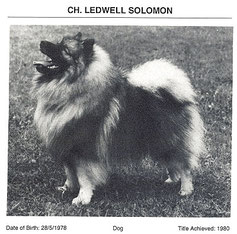The Keeshond
Dutch Wolfspitz or a completely different breed?
CONTENTS:
Anyone who is interested in the Wolfsspitz breed will inevitably be confronted with the term “Keeshond”. And he will notice that there are very different looking breed representatives, namely the Wolfsspitz type and the Keeshond type. Only very few people can do anything with it, and my impression is that there is definitely a need for information here. At this point, I will attempt to explain the similarities and differences between these two varieties of the breed.
Different or local breeds?
It is very common to read that the Wolfsspitz is called Keeshond abroad, from which it is usually assumed that they are the same thing. But this is only partly true. The statement whether the Wolfsspitz is called a Keeshond abroad must firstly depend on which country we are talking about. The word "Keeshond" is Dutch and means the same thing in Holland as "Spitz" in Germany. "Hond" simply means "dog".
By the way, Keeshond pronounces itself “Kays-Hond.” The pronunciation “Kees-Hound” is completely wrong. The "Hounds" in English belong to the group of hunting and pack dogs - i.e. Beagles, Bloodhounds, Foxhounds, etc. Furthermore, the pronunciation "Kee-shon", that I already heard on the internet, is more than wrong.
"Keeshond" is a generic term for all varieties of the German Spitz breed in the Netherlands. In Holland, the Wolfsspitz is called “Grote grijze Keeshond” (“Big Gray Spitz”) or “Wolfsgrijze Keeshond” (“Wolf Gray Spitz”). The other varieties are: "Grote Keeshond" / Giant Spitz, "Middelgrote Keeshond" / Mittel Spitz etc. In Eastern European countries the term "Wolfsspitz" is well known and used, and a distinction is also made between Wolfsspitz and Keeshond.
The Wolfsspitz was widespread throughout Central Europe before and around 1900. There are various theories about the origin of the word Keeshond, but the best known is the following: "Kees" is the short form and pet form of the first name Cornelius or Cornelis. Around 1781, the Dutch patriot Cornelis de Gyzelaar was leader of the People's Party, which was in opposition to the Orange Party (the Conservatives). The Orangemen wanted the Prince of Orange as their king, the Patriots did not. That Kees had a Wolfsspitz and so the "Hond" of "Kees" became the "Keeshond" and the symbol of the Patriot Party, while the pug became the symbol of the Orangemen.
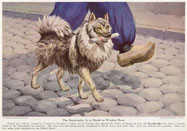
It can be assumed that the Wolfsspitz came to Holland in the first place through the barges on the Rhine, because the Rhine always connected Germany and Holland. And just because the Wolfsspitz was now called a Keeshond due to a political event in the 18th century, there was never any justified reason to speak of two different breeds. Our Wolfsspitz was definitely very popular in Holland and was also crossed with other Spitz varieties, so over time it lost some of its original nature. It was usually smaller than our Wolfsspitz and often gray-brown in color. The different breeds of the Wolfsspitzes were certainly also due to the fact that a Wolfsspitz on a Bavarian farm had to be bigger so that his impressive appearance alone kept rogues away. The carter or boatman, on the other hand, probably preferred a slightly smaller and more transportable dog in his cramped vehicle.
The split of the Keeshond from Wolfspitz
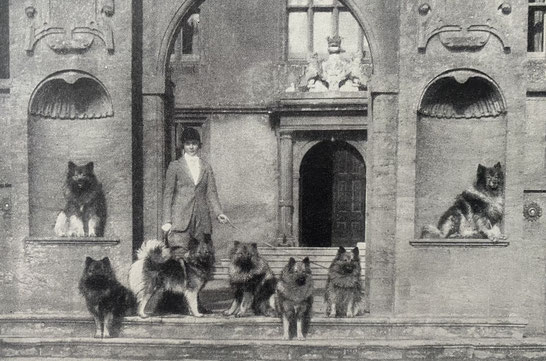
The German Wolfsspitz and the Dutch Keeshond appear to have a common origin, but their breeding followed somewhat different lines. From both sides of the Lower Rhine, the breed found its way to Great Britain at the beginning of the 20th century - thanks to the efforts of a lady named Gwendolen Wingfield-Digby, who introduced the first Wolfsspitz from Germany and set up a breed under the name "Van Zaandam Kennels" and campaigned for the recognition of this breed there.
Mrs. Wingfield-Digby encountered the breed in her youth during a stay in the Netherlands, where she first saw the Keeshonden majestically perched on small boats, fell in love and brought it with her to England. It was not until 1925 that a kennel club was founded there under her chairmanship. Since then, the breeding and popularity of Keeshonden has steadily increased in England. Mrs. Wingfield-Digby also introduced German Wolfsspitzes, including names such as "Horst and Christel am Ziel", "Billo von der Maiblume" and "Alli von der Sternwarte", with which she established her breeding. Importing the Wolfsspitzes or Keeshonden to England was not an easy matter at that time, considering the quarantine of several months. However, Mrs. Wingfield-Digby always stuck to the original types in her kennel "Van Zaandam" and continued this line from 1902 onwards. The modern, slightly flashier and chow-like type never found her sympathy - she was always in opposition to the breeders of this modern type. For her, the Keeshond should be a useful dog that would be a good guardian and accompany her on all her travels. If her dogs didn't have the lush woolly hair desired at the dog shows, she always countered: "For me, that's enough! ". The dogs in her kennel were all dark rather than light, with a tough constitution and good guards, but not snappy or aggressive.
The Keeshond became increasingly popular in England over the years, but from the 1960s onwards, a particular phenotype began to be preferred in breeding, namely the more voluptuous chow types. From Great Britain, the Wolfsspitze's triumphal march began under the name "Keeshond" to Scandinavia and overseas.
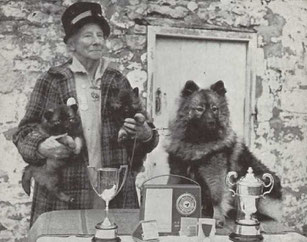
From this it follows: "Keeshond" is the name for a Wolfsspitz of a certain breed with a corresponding, typical phenotype, which can certainly be described as a show dog type. Officially there are only Keeshonden in the Anglo-Saxon countries - but that doesn't mean that there are no Wolfspitz types there! Both varieties ultimately have the same genetic heritage. However, since a certain phenotype (namely that of the Keeshond) is preferred and aimed at in breeding, representatives of the Wolfsspitz phenotype are usually sold there as so-called "pet quality" ("pet quality" as opposed to "breed quality") to lovers without interest in breeding sold.
But where exactly is the difference? The Keeshond is smaller and more compact and has a stronger skeleton. The head is finer, has a more pronounced stop and a wider forehead, the muzzle is shorter, the ears are smaller. The Keeshond has significantly more fur, especially on the neck and legs, all with plenty of undercoats. Keeshonds are often lighter, with larger cream-colored parts and shades of beige and tending towards orange - but always with the characteristic markings that they have in common with the Wolfsspitz.
In contrast, Wolfsspitz pups are born almost black and the adult wolf is pure wolf gray, with no other color. The Wolfsspitz is larger, has less contrast in color, a lighter skeleton, a longer muzzle, larger ears and its coat is more moderate. While the Keeshond looks like a cute teddy bear and is a family dog by nature, the Wolfsspitz appears much rougher - not to say more formidable - and is still a very dutiful guard dog.
Although all Dutch Keeshonden have the Wolfsspitz as ancestor, from 1927 onwards in Holland they wanted to separate the two breeds and divided the classes at dog shows into "German Keeshonden" and "Dutch Keeshonden". In 1933, a separate standard was approved for the "Hollandsche Keeshonden", which, however, hardly differed from the Wolfsspitz standard. Sometimes at dog shows it even happened that the same dog was classified as a "Keeshond" and once as a "Wolfsspitz" by different judges. This practice caused so much confusion that foreign newspapers even referred to the Keeshond as a "Dutch breed". It was not possible for German emigrant Mr. Hinderer to have his Wolfsspitzes registered under its German name in the USA around 1930. It was not until 1960 that the FCI finally canceled the “Hollandsche Keeshond” standard without replacing it and defined Germany as the sole country of origin of the breed. In England, the Wolfspitz was called the "Dutch Barge Dog" until it was officially called "Keeshond" in 1926, although Holland was also considered to be its country of origin.
The Wolfspitz also arrived in the USA through German immigrants who came with their animals - and here too Wolfsspitz ultimately lost his name. Why? "Wolfsspitz" simply sounded too German, because of the war there was an aversion to everything German. German Shepherd Dog was no longer called by his original name for a while, but "Alsatian", just as the white Spitz has since been called "American Eskimo Dog" in the USA.
"Keeshond" became established abroad, so that in the USA, Scandinavia, Australia etc. the breed is only known by this new name - although Germany, as the country of origin, keeps the studbook by the FCI is. In addition, the English Keeshonden are based 1/3 on Keeshonden from Holland and 2/3 on Wolfsspitzes from Germany.

The difference between Wolfsspitz and Keeshond briefly explained
The modern Keeshond type
Initially, the type of Anglo-American Keeshonds largely corresponded to the German Wolfsspitz and only recently have they increasingly developed into a type that is more reminiscent of the Chow or the Pomeranian. Since around the 1960s, the breeding styles of Wolfsspitzes or Keeshonden began to drift apart immensely. So that everyone can form their own opinion, we now time-travel through the world of the Keeshonden up from 1927:
In Germany and its neighboring countries, many Wolfsspitzes were still kept in the countryside in their original function as guard dogs. In England and the USA, however, the Keeshond was viewed more as a family dog and was therefore bred more for "show" than for working qualities. Until 1987 the English lines remained effectively isolated. Among other things, the strict quarantine regulations in the last century meant that English and Scandinavian breeders did not follow the development of the Wolfsspitz in Central Europe, but rather developed their own type more and more over the decades. Although there were isolated imports to Germany, there were hardly any exports from German lines to Northern Europe.
Gradually, the English dogs became smaller, with a more delicate head type and more lush fur. This change in type took place in stages and was by no means popular with all Keeshond friends. Overall, the breed has become much more uniform in appearance since the 1960s, so that people now speak of the "modern Keeshond" in contrast to the "old type". In the United States, trends were similar, although due to the large breeding base there were many different types until about 1970. Unfortunately, the appearance soon became more uniform: more compact with a lot of fur. Since 1980, a pronounced stop has been particularly required for the head type. As in England, in the USA the beautiful, silver-grey color of the fur soon gave way to a cream tone, which gave a rather faded impression.
Brothers or distant relatives?

Since England, the USA and Canada are not affiliated with the FCI, they maintain their own breed standards. Nevertheless, the standards of Wolfsspitz and Keeshond are quite the same. The most noticeable difference was and is the size. However, although the Keeshond countries aim for a smaller size, their standard is worded so that larger dogs are not completely excluded. The 1939 AKC standard requires a minimum size of 15 inches (=38.5 cm), which appears to have been adopted from the German standard. In Germany, however, people have been breeding for size since 1900, so that Wolfsspitze with a shoulder height of more than 50 cm were considered the breeding goal.
Nevertheless, there were really large and powerful Keeshonds until the 1970s. Only through the standardization of the type was the average shoulder height reduced. Nevertheless, for many years the Keeshond could hardly be distinguished from the Wolfsspitz; it was just a little smaller and more delicately built. This is why German breeders have also become very fond of the Keeshonds and are very happy to import them to refresh blood.
And yet, even in the 1950s, the development of the Keeshond was viewed with concern in this country. Among other things, Mrs. Weitz - the "Grande Dame" of the German Wolfsspitz breeders with her kennel "vom Wymarshof" - pointed out that the lush plushy coat of the Keeshonden, as beautiful as it was, required an enormous amount of grooming - much, much more than the thick and hard hair of the local Wolfspitz.
However, the German breeders were not very enthusiastic about the new type that was favored from the 1970s onwards - the Chow or Pomeranian type - especially since at that time particularly strong dogs tended to win prizes at dog shows.
Although Keeshond and Wolfsspitz differ noticeably, this is not due to the standards, which basically list the same errors worldwide. Ultimately, tastes differ in different countries, which then creates a certain type due to increased demand. In addition to taste, which always corresponds to a certain zeitgeist, peer pressure (judges are subject to this in their decisions) and habituation (a frequently seen type is considered normal) also created the Keeshond as we know it today.

There really isn't a more understandable or fun way to show the difference between a Keeshond and a Wolfsspitz 😆 Video courtesy of Tomasz Bednarski
The current Keeshond situation

In the mid-90s, an application was made to the FCI to recognize an own standard for the Keeshond as a Dutch breed; the initiators at the time were Scandinavian breeders. These were in a special situation in Northern Europe, where Wolfsspitzes have been known and widespread since 1950, because although the FCI standard officially applied here too, the quarantine regulations made it much easier for the Scandinavians to import animals from England than from the Central Europe. When the quarantine regulations were abolished and Scandinavians also had the opportunity to attend dog shows in Europe, they feared that their dogs would be disadvantaged because the dogs differed significantly from the European Wolfsspitzes in terms of head type, size and pattern.
The German Spitz Club, as the club that keeps the studbook of the breed, spoke out against its own Keeshond standard, so it was commissioned by the FCI - without even being asked by the FCI in advance - to somehow incorporate the Keeshond into the standard for Wolfspitz. The main arguments for the common standard were the similarity of the ideal types and the close relationship between Wolfsspitz and Keeshond - evidenced both by the same ancestors and by regular mating.

A theoretical advantage of the new, common standard was that breeders now suddenly had a much broader breeding base. The disadvantage, however, was that the larger and more robust Wolfsspitzes from Germany were replaced by the smaller and cuter Dutch, British and American Keeshonden, which no longer have much in common with the original Wolfsspitz type and its typical gait. There is nothing inherently wrong with incorporating the Keeshond into our standard - or with breeding with it - as long as it is the Keeshond from 50 years ago. PHPT and the skin disease Alopecia X were introduced into the healthy Wolfsspitz population by the Keeshonden.
In the past, the focus of Wolfsspitz breeding was on their health - and the healthy Wolfspitzes thanked their breeders with long life and high fertility (litters with more than eight puppies were not uncommon). The original Wolfsspitz also needed only a few brush strokes and was admired for its natural-looking coat. Today, unfortunately, even gray-coated Eurasians sometimes bear more resemblance to the classic Wolfsspitz than the modern Keeshond. However, the demand for the traditional Wolfsspitz type or “original Wolfsspitz type” still exists, and some people interested in puppies are noticing with great regret that this old breed, which they valued for its various characteristics, is increasingly being pushed out.
I hope that the differences between the two breeding lines became a little clearer through the comparison above within this breed portrait. In Germany, it is now the case that dogs can no longer necessarily be assigned to a specific type, as both types have been crossbred together for a long time.
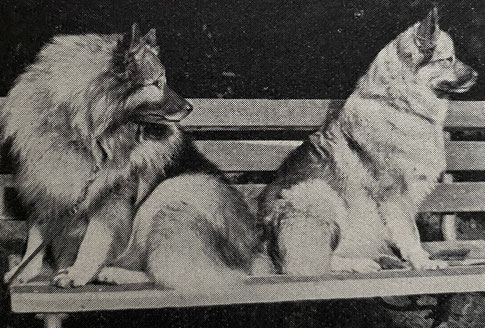
Astrid Renken (the lady to whom we owe the Spitz database) once provided a list on her homepage where she listed local breeders broken down by type of dogs bred to help those interested in puppies who were looking for a specific type (Wolfsspitz or Keeshond type). She was then threatened with “legal action” because her list was “damaging to business.” Business??? Interesting. And I always thought that we only had warmhearted hobby breeders who “don’t earn anything” from it and only do everything “out of love for the breed”. Of course, something like that makes you look deeply!
For the promotion of our old Wolfspitz type, the approval of magnificent registry dogs would be welcome, as would the approval of dogs whose ancestry can be verified in many cases, since the parents have papers, but the owners could not be persuaded to go to dog shows where they would have to compete with the Keeshonden. Because at the shows, a different type is favored than by the many people interested in puppies. These usually require a Wolfsspitz whose figure is still somewhat recognizable despite the beautiful fur.
Our breeders should therefore try to use the Keeshonden gene reservoir for the Wolfsspitz when it makes sense. But they shouldn't let our old lines die out because of their enthusiasm for the Keeshonden, because it would really be a shame for the robust, German Wolfsspitz!
04.09.2023









